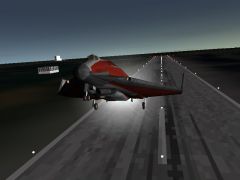Difference between revisions of "Delta-glider"
Jump to navigation
Jump to search
(scramjet comment, corrected fuel qty) |
m |
||
| Line 50: | Line 50: | ||
The [[scramjet]] variant, Deltaglider-S, splits its main fuel tank into 10,400kg for the main drives and 4,000kg for the scramjets. | The [[scramjet]] variant, Deltaglider-S, splits its main fuel tank into 10,400kg for the main drives and 4,000kg for the scramjets. | ||
Their effective operating range is [[Mach]] 3-8. | Their effective operating range is [[Mach]] 3-8. | ||
| + | |||
| + | [[Category:Vessels of Orbiter]] | ||
Revision as of 20:20, 7 March 2007
| Delta-glider | |
|---|---|

| |
| Delta-glider in atmosphere | |
| Description | |
| Role | Glider |
| Full name | Delta-glider |
| Crew | 1 |
| Passengers | 4 |
| First flight | date unknown |
| Entered service | date unknown |
| Manufacturer | unknown |
| Dimensions | |
| Length | 17.76 m |
| Height | 4.93 m |
| Wingspan | 17.86 m |
| Wing area | 160 m2 |
| Masses | |
| Empty | 12,000 kg |
| Fuel | 14,400 kg |
| RCS fuel | 600 kg |
| Max. take-off | 27,000 kg |
| Inertia PMI | 15.5 / 22.1 / 7.7 m2 |
| Performance | |
| Max. delta-v | 31.5 km/s |
| Max. accel | 20 m/s2 |
| Stall CL | 1.0 |
| Stall AOA | 20° |
The Delta-glider is the ideal ship for the novice pilot to get spaceborne. Its futuristic design concept, high thrust and extremely low fuel consumption make it easy to achieve orbit, and it can even be used for interplanetary travel. The winged design provides aircraft-like handling in the lower atmosphere, while the vertically mounted hover-thrusters allow vertical takeoffs and landings independent of atmospheric conditions and runways.
It comes with the stock Orbiter install.
The scramjet variant, Deltaglider-S, splits its main fuel tank into 10,400kg for the main drives and 4,000kg for the scramjets. Their effective operating range is Mach 3-8.